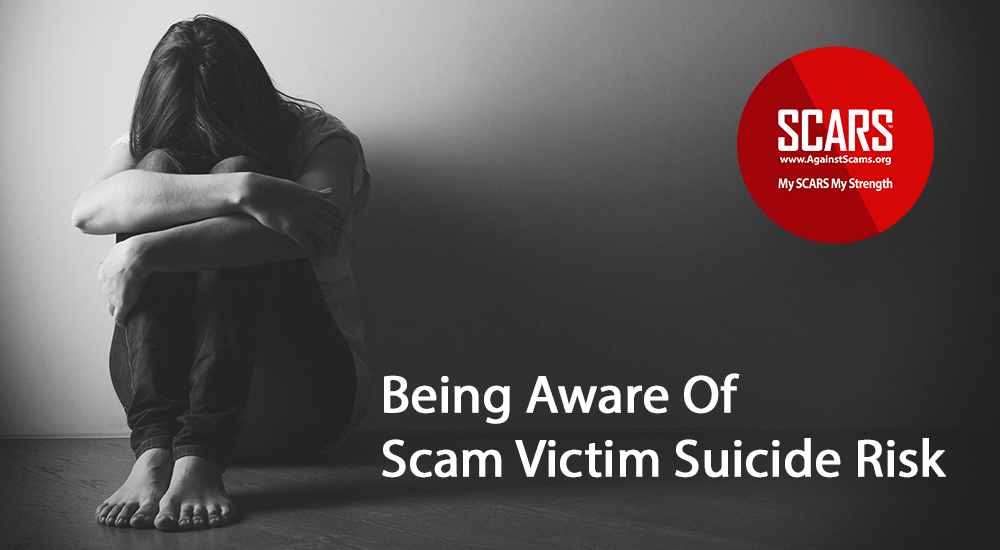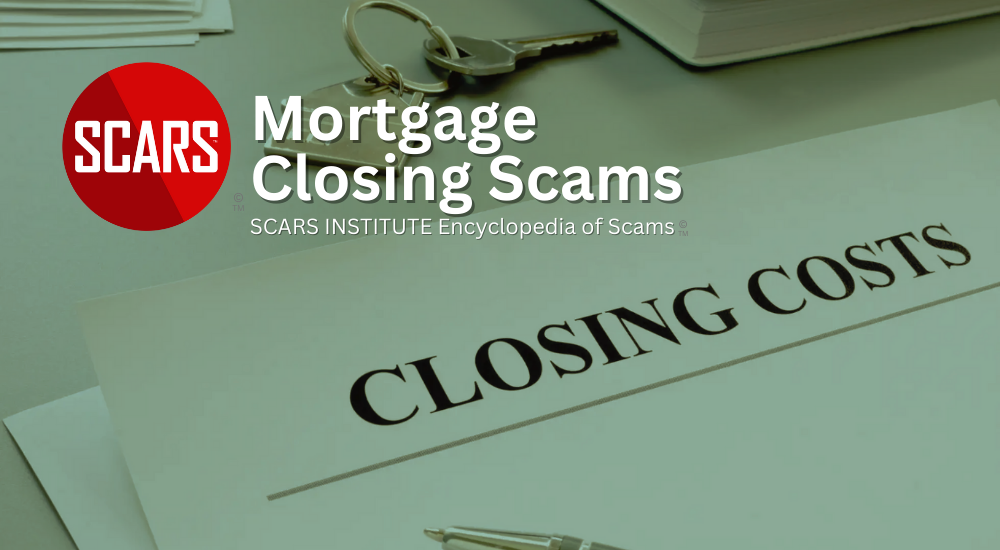Being Aware Of Scam Victim Suicide Risk
A SCARS Guide
As with anyone who has been traumatized and dealt a devastating blow in their life, scam victims experience all of the depression and negative behavioral impact of anyone in similar situations.
It is important to recognize that suicide is a real risk for scam victims.
SCARS Estimates That Between 12 – 20 Victims Commit Suicide A Day!
The following article from Healthline.com provides the necessary information to recognize, understand, and steps to take to help someone in need.
What is suicide and suicidal behavior?
Suicide is the act of taking one’s own life. According to the American Foundation for Suicide Prevention, suicide is the 10th leading cause of death in the United States, taking the lives of approximately 47,000 Americans each year.
Suicidal behavior refers to talking about or taking actions related to ending one’s own life. Suicidal thoughts and behaviors should be considered a psychiatric emergency.
If you or someone you know is exhibiting either, you should seek immediate assistance from a healthcare provider.
Warning signs that someone may attempt suicide
You can’t see what a person is feeling on the inside, so it isn’t always easy to identify when someone is having suicidal thoughts. However, some outward warning signs that a person may be contemplating suicide include:
- talking about feeling hopeless, trapped, or alone
- saying they have no reason to go on living
- making a will or giving away personal possessions
- searching for a means of doing personal harm, such as buying a gun
- sleeping too much or too little
- eating too little or eating too much, resulting in significant weight gain or loss
- engaging in reckless behaviors, including excessive alcohol or drug consumption
- avoiding social interactions with others
- expressing rage or intentions to seek revenge
- showing signs of extreme anxiousness or agitation
- having dramatic mood swings
- talking about suicide as a way out
It can feel scary, but taking action and getting someone the help they need may help prevent a suicide attempt or death.
How to talk to someone who is feeling suicidal
If you suspect that a family member or friend may be considering suicide, talk to them about your concerns. You can begin the conversation by asking questions in a non-judgmental and non-confrontational way.
Talk openly and don’t be afraid to ask direct questions, such as “Are you thinking about suicide?”
During the conversation, make sure you:
- stay calm and speak in a reassuring tone
- acknowledge that their feelings are legitimate
- offer support and encouragement
- tell them that help is available and that they can feel better with treatment
Make sure not to minimize their problems or attempts at shaming them into changing their mind. Listening and showing your support is the best way to help them. You can also encourage them to seek help from a professional.
Offer to help them find a healthcare provider, make a phone call, or go with them to their first appointment.
It can be frightening when someone you care about shows suicidal signs. But it’s critical to take action if you’re in a position to help. Starting a conversation to try to help save a life is a risk worth taking.
If you’re concerned and don’t know what to do, you can get help from a crisis or suicide prevention hotline.
If you live in the United States, try the National Suicide Prevention Lifeline at 800-273-TALK (800-273-8255). They have trained counselors available 24/7. Stop a Suicide Today is another helpful resource.
Befrienders Worldwide and the International Association for Suicide Prevention are two organizations that provide contact information for crisis centers outside of the United States.
In cases of imminent danger
According to the National Alliance on Mental Illness (NAMI), if you notice someone doing any of the following, they should get care immediately:
- putting their affairs in order or giving away their possessions
- saying goodbyes to friends and family
- having a mood shift from despair to calm
- planning, looking to buy, steal, or borrow the tools to complete a suicide, such as a firearm or medication
If you think someone is at immediate risk of self-harm:
- Call 911 or your local emergency number.
- Stay with the person until help arrives.
- Remove any guns, knives, medications, or other things that may cause harm.
- Listen, but don’t judge, argue, threaten, or yell.
What increases the risk of suicide?
There’s usually no single reason someone decides to take their own life. Several factors can increase the risk of suicide, such as having a mental health disorder.
But more than halfTrusted Source of all people who die by suicide don’t have a known mental illness at the time of their death.
Depression is the top mental health risk factor, but others include bipolar disorder, schizophrenia, anxiety disorders, and personality disorders.
Aside from mental health conditions, other factors that increase the risk of suicide include:
- incarceration
- poor job security or low levels of job satisfaction
- history of being abused or witnessing continuous abuse
- being diagnosed with a serious medical condition, such as cancer or HIV
- being socially isolated or a victim of bullying or harassment
- substance use disorder
- childhood abuse or trauma
- family history of suicide
- previous suicide attempts
- having a chronic disease
- social loss, such as the loss of a significant relationship
- loss of a job
- access to lethal means, including firearms and drugs
- being exposed to suicide
- difficulty seeking help or support
- lack of access to mental health or substance use treatment
- following belief systems that accept suicide as a solution to personal problems
Those who have been shown to be at a higher risk for suicide are:
- men
- people over age 45
- Caucasians, American Indians, or Alaskan Natives
Assessing people who are at risk for suicide
A healthcare provider may be able to determine whether someone is at high risk for suicide based on their symptoms, personal history, and family history.
They will want to know when symptoms started and how often the person experiences them. They’ll also ask about any past or current medical problems and about certain conditions that may run in the family.
This can help them determine possible explanations for symptoms and which tests or other professionals might be needed to make a diagnosis. They will likely make assessments of the person’s:
- Mental health. In many cases, thoughts of suicide are caused by an underlying mental health disorder, such as depression, schizophrenia, or bipolar disorder. If a mental health issue is suspected, the person will likely be referred to a mental health professional.
- Substance use. Misusing alcohol or drugs often contributes to suicidal thoughts and behavior. If substance use is an underlying problem, an alcohol or drug addiction rehabilitation program may be the first step.
- Medications. The use of certain prescription drugs — including antidepressants — may also increase the risk of suicide. A healthcare provider can review any medications the person is currently taking to see if they could be contributing factors.
Treatment for people who are at risk for suicide
Treatment will depend on the underlying cause of someone’s suicidal thoughts and behavior. In many cases, though, treatment consists of talk therapy and medication.
Talk therapy
Talk therapy, also known as psychotherapy, is one possible treatment method for lowering your risk of attempting suicide. Cognitive behavioral therapy (CBT) is a form of talk therapy that’s often used for people who are having thoughts of suicide.
Its purpose is to teach you how to work through stressful life events and emotions that may be contributing to your suicidal thoughts and behavior. CBT can also help you replace negative beliefs with positive ones and regain a sense of satisfaction and control in your life.
A similar technique, called dialectical behavioral therapy (DBT), may also be used.
Medication
If talk therapy isn’t enough to successfully lower risk, medication may be prescribed to ease symptoms, such as depression and anxiety. Treating these symptoms can help reduce or eliminate suicidal thoughts.
One or more of the following types of medication could be prescribed:
- antidepressants
- antipsychotic medications
- anti-anxiety medications
Lifestyle changes
In addition to talk therapy and medication, suicide risk can sometimes be reduced by simply adopting certain healthy habits. These include:
- Avoiding alcohol and drugs. Staying away from alcohol and drugs is critical, as these substances can lower inhibitions and may increase the risk for suicide.
- Exercising regularly. Exercising at least three times per week, especially outdoors and in moderate sunlight, can also help. Physical activity stimulates the production of certain brain chemicals that make you feel happier and more relaxed.
- Sleeping well. It’s also important to get enough quality sleep. Poor sleep can make many mental health symptoms much worse. Talk to your healthcare provider if you’re having trouble sleeping.
How to prevent suicidal thoughts
If you’ve had suicidal thoughts or feelings, don’t be ashamed and don’t keep it to yourself. While some people have suicidal thoughts without any intention of ever acting on them, it’s still important to take some action.
To help prevent these thoughts from recurring, there are several things you can do.
Talk to someone
You should never try to manage suicidal feelings entirely on your own. Getting professional help and support from loved ones can make it easier to overcome any challenges that are causing these feelings.
Many organizations and support groups can help you cope with suicidal thoughts and recognize that suicide isn’t the best way to deal with stressful life events. The National Suicide Prevention Lifeline is a great resource.
Take medications as directed
You should never change your dosage or stop taking your medications unless your healthcare provider tells you to do so. Suicidal feelings may recur and you may experience withdrawal symptoms if you suddenly stop taking your medications.
If you’re having unwanted side effects from the medication you’re currently taking, speak with your provider about switching to another one.
Never skip an appointment
It’s important to keep all your therapy sessions and other appointments. Sticking with your treatment plan is the best way to deal with suicidal thoughts and behavior.
Pay attention to warning signs
Work with your healthcare provider or therapist to learn about the possible triggers for your suicidal feelings. This will help you recognize the signs of danger early on and decide what steps to take ahead of time.
It can also help to tell family members and friends about the warning signs so they can know when you may need help.
Eliminate access to lethal methods of suicide
Get rid of any firearms, knives, or serious medications if you worry that you might act on suicidal thoughts.
Suicide prevention resources
The following resources provide trained counselors and information about suicide prevention:
- National Suicide Prevention Lifeline: Call 800-273-8255. The Lifeline provides 24/7, free and confidential support for people in distress, prevention and crisis resources for you or your loved ones, and best practices for professionals.
- National Suicide Prevention Lifeline Chat: The Lifeline Chat connects individuals with counselors for emotional support and other services via web chat, 24/7 across the United States.
- Crisis Text Line: Text HOME to 741741. The Crisis Text Line is a free text messaging resource offering 24/7 support to anyone in crisis.
- Substance Abuse and Mental Health Services Administration (SAMHSA) National Helpline: Call 1-800-662-HELP (4357). SAMHSA’s helpline is a free, confidential, 24/7, 365-day-a-year treatment referral and information service (in English and Spanish) for individuals and families facing mental health or substance use disorders.
- Befrienders Worldwide and the International Association for Suicide Prevention: These are two organizations that provide contact information for crisis centers outside of the United States.
Outlook
Today, many organizations and people are working hard on suicide prevention, and there are more resources available than ever. No one should have to deal with suicidal thoughts alone.
Whether you’re a loved one who’s concerned about someone or you’re struggling yourself, help is available. Don’t keep silent — you may help save a life.
NOTE: We thank Healthline.com for this information which we present for the benefit of our audience. Please visit there website for more information: https://www.healthline.com/health/suicide-and-suicidal-behavior
TAGS: SCARS, Information About Scams, Romance Scams, Scam Victims, Suicide, Committing Suicide, Preventing Suicide
SCARS™ Team
Society of Citizens Against Relationship Scams Inc.
A Worldwide Crime Victims Assistance Nonprofit Organization
Visit: www.AgainstScams.org
Contact Us: Contact@AgainstScams.org
PLEASE SHARE OUR ARTICLES WITH YOUR FRIENDS & FAMILY
HELP OTHERS STAY SAFE ONLINE – YOUR KNOWLEDGE CAN MAKE THE DIFFERENCE!
The Latest SCARS Posts:
FIND MORE SCAM NEWS
«SCAMCRIME.COM»
JOIN US ON FACEBOOK
«CLICK HERE»
END
MORE INFORMATION
– – –
Tell us about your experiences with Romance Scammers in our
« Scams Discussion Forum on Facebook »
– – –
FAQ: How Do You Properly Report Scammers?
It is essential that law enforcement knows about scams & scammers, even though there is nothing (in most cases) that they can do.
Always report scams involving money lost or where you received money to:
- Local Police – ask them to take an “informational” police report – say you need it for your insurance
- U.S. State Police (if you live in the U.S.) – they will take the matter more seriously and provide you with more help than local police
- Your National Police or FBI « www.IC3.gov »
- The SCARS|CDN™ Cybercriminal Data Network – Worldwide Reporting Network on « www.Anyscam.com »
This helps your government understand the problem, and allows law enforcement to add scammers on watch lists worldwide.
– – –
To learn more about SCARS visit « www.AgainstScams.org »
Please be sure to report all scammers
on « www.Anyscam.com »
Disclaimer:
SCARS IS A DIGITAL PUBLISHER AND DOES NOT OFFER HEALTH OR MEDICAL ADVICE, LEGAL ADVICE, FINANCIAL ADVICE, OR SERVICES THAT SCARS IS NOT LICENSED OR REGISTERED TO PERFORM.
IF YOU’RE FACING A MEDICAL EMERGENCY, CALL YOUR LOCAL EMERGENCY SERVICES IMMEDIATELY, OR VISIT THE NEAREST EMERGENCY ROOM OR URGENT CARE CENTER. YOU SHOULD CONSULT YOUR HEALTHCARE PROVIDER BEFORE FOLLOWING ANY MEDICALLY RELATED INFORMATION PRESENTED ON OUR PAGES.
ALWAYS CONSULT A LICENSED ATTORNEY FOR ANY ADVICE REGARDING LEGAL MATTERS.
A LICENSED FINANCIAL OR TAX PROFESSIONAL SHOULD BE CONSULTED BEFORE ACTING ON ANY INFORMATION RELATING TO YOUR PERSONAL FINANCES OR TAX RELATED ISSUES AND INFORMATION.
This content and other material contained on the website, apps, newsletter, and products (“Content”), is general in nature and for informational purposes only and does not constitute medical, legal, or financial advice; the Content is not intended to be a substitute for licensed or regulated professional advice. Always consult your doctor or other qualified healthcare provider, lawyer, financial, or tax professional with any questions you may have regarding the educational information contained herein. SCARS makes no guarantees about the efficacy of information described on or in SCARS’ Content. The information contained is subject to change and is not intended to cover all possible situations or effects. SCARS does not recommend or endorse any specific professional or care provider, product, service, or other information that may be mentioned in SCARS’ websites, apps, and Content unless explicitly identified as such.
The disclaimers herein are provided on this page for ease of reference. These disclaimers supplement and are a part of SCARS’ website’s Terms of Use.
Legal Notices:
All original content is Copyright © 1991 – 2020 Society of Citizens Against Relationship Scams Inc. (D.B.A SCARS) All Rights Reserved Worldwide & Webwide. Third-party copyrights acknowledge.
SCARS, SCARS|INTERNATIONAL, SCARS, SCARS|SUPPORT, SCARS, RSN, Romance Scams Now, SCARS|INTERNATION, SCARS|WORLDWIDE, SCARS|GLOBAL, SCARS, Society of Citizens Against Relationship Scams, Society of Citizens Against Romance Scams, SCARS|ANYSCAM, Project Anyscam, Anyscam, SCARS|GOFCH, GOFCH, SCARS|CHINA, SCARS|CDN, SCARS|UK, SCARS|LATINOAMERICA, SCARS|MEMBER, SCARS|VOLUNTEER, SCARS Cybercriminal Data Network, Cobalt Alert, Scam Victims Support Group, are all trademarks of Society of Citizens Against Relationship Scams Inc., All Rights Reserved Worldwide
Contact the law firm for the Society of Citizens Against Relationship Scams Incorporated by email at legal@AgainstScams.org











Leave A Comment